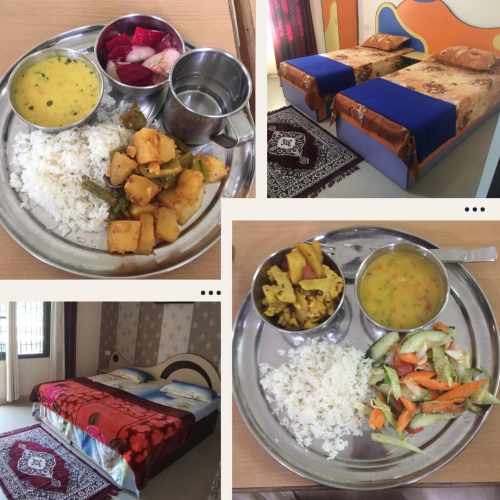Sound Healing Teacher Training Course in Rishikesh, India
Sound Healing Teacher Training Course in Rishikesh, India
In today’s world, sound healing has experienced a resurgence as a powerful therapeutic practice. Utilizing vibrational sound healing instruments, Sound Healing Therapy has been employed throughout the ages to treat humanity.
Nada Yoga School is one of the Classical and oldest Yoga Schools in Rishikesh, India offering certification courses in sound healing to become a professional sound healer. This comprehensive program is designed to equip individuals with the necessary skills to become professional sound healers. Throughout the course, participants will delve into the various facets of sound healing techniques and their profound ability to restore well-being. The exclusive sound healing course spans 4 levels – beginner, intermediate, advanced and Pro. Each level, which lasts for a week, builds upon the previous one, providing a comprehensive understanding of the healing process.
Sound healing has been widely acknowledged as a powerful and scientifically proven method for alleviating stress and promoting physical and mental well-being. By harnessing the vibrational effects of sound, this technique aids in the release of toxins from the body. It not only restores balance to the mind but also has a profound impact on the body and soul.
Through the implementation of harmonic vibrations, sound therapy enhances an individual’s overall health and vitality. This emerging trend in the healing industry addresses imbalances in the energy field, utilizing techniques such as sound, chanting, and toning to facilitate positive transformations in individuals.
What is Sound Healing Therapy?
Sound healing therapy is a practice that uses sound waves to improve a person’s physical, mental, and emotional well-being. The therapy uses various instruments, such as gongs, Tibetan singing bowls, mantras, chimes, and tuning forks, to produce specific frequencies and vibrations that can affect a person’s body and mind.
The effects of sound healing therapy can vary from person to person, but many people report feeling relaxed, calm, and rejuvenated after a session. Research has also suggested that sound healing therapy may be helpful for reducing stress, anxiety, and pain.
The theory behind sound healing therapy is that everything in the universe, including our bodies, is made up of energy and vibrates at a certain frequency. When our bodies are in a state of disharmony, illness, or stress, they vibrate at a lower frequency. Sound healing therapy aims to restore the body’s natural frequency by using sound waves to entrain the body’s cells and organs to vibrate at a higher frequency, promoting healing and relaxation.
During a sound healing therapy session, the therapist will typically play various instruments around and sometimes on the person’s body. The person may lie down or sit in a comfortable position and allow the sounds to wash over them. The therapist may also use guided meditations, affirmations, or visualization techniques to enhance the effects of the sound waves.
Course Details:
The combination of ethnic tuning forks, drums, sound baths, gongs, magnets, mantras, and Tibetan singing bowls has proven to be an effective method for alleviating various types of stress. To harness the tranquil essence of sound and facilitate a state of mental and physical well-being, Nada Yoga School offers a Sound Healing Teacher Training Course in Rishikesh, India.


Sound Healing Therapy Course Details
Sound healing therapy is a specific type of sound therapy that uses traditional spiritual instruments such as singing bowls, gongs, cymbals, and bells to produce deep, resonant vibrations that can help to heal the body and mind.
What you can expect to learn in this sound healing therapy course?
- History and philosophy of sound healing: You will learn about the origins of sound healing, the traditional instruments used, and the underlying principles and beliefs that guide the practice.
- Introduction to Tibetan instruments: You will learn how to play various Tibetan instruments such as singing bowls, gongs, cymbals, and bells, including proper techniques for striking and manipulating the instruments to produce different sounds and vibrations.
- Techniques for healing and relaxation: You will learn how to use Tibetan sound healing techniques to promote relaxation, reduce stress and anxiety, and support physical and emotional healing. You may also learn how to incorporate guided meditations, affirmations, and visualization techniques to enhance the effects of sound vibrations.
- Practice sessions: You will have the opportunity to practice playing the instruments and leading sound healing sessions with other students. You may also receive feedback from instructors to help you improve your technique and develop your own sound healing style.
- Career as a sound healer: If you plan to offer sound healing therapy as a service, this course will include information on how to start and conduct a sound healing practice.
- Certification: This course will offer certification upon completion, indicating that you have acquired the necessary skills and knowledge to practice Tibetan sound healing therapy professionally.
- Demonstrate a complete, systematized understanding of yogic techniques and concepts,
- Effectively instruct open classes,
- Ideally, adjust people in asanas,
- Know your audience and sequence individual classes and build programs for your audiences,
- Create an atmosphere for development, growth, and self-study in a class in a number of ways,
- Easily sequence and structure 60-90 minute classes that will deeply affect the lives of your students.
The Purpose of the Sound Healing Teacher Training Course:
The Sound Healing Teacher Training Course does not require any prior experience in Sound Healing Techniques. This comprehensive 28-day program covers the fundamental aspects of sound healing techniques and their applications in healing humanity. Tibetan bowl singing, employed for 2500 years to address physical and emotional ailments, takes center stage in this course. Additionally, participants learn about the theoretical uses and benefits of other sound-healing instruments, including gongs, bells, tuning forks, cymbals, drums, magnets, rainsticks, wind chimes, pan flutes, and mantras.
At Nada Yoga School, we are dedicated to promoting the ancient healing therapies of India. Our aim is to cultivate individuals into professional sound healing teachers. The Sound Healing Teacher Training Course at Nada Yoga School not only equips you with the skills to become an adept teacher but also transforms you into a self-sufficient practitioner. Our experienced sound healers strive to provide comprehensive theoretical and practical knowledge throughout the course. We are committed to training our students to become proficient sound healers, ready to make a positive impact in the field.
Here are some key aspects typically covered in a sound healing teacher training program:
Understanding Sound Healing: Participants learn about the principles, theories, and philosophies behind sound healing. This includes the exploration of different sound healing modalities, the science behind sound therapy, and the effects of sound vibrations on the body and mind.
Sound Instruments and Techniques: Trainees are introduced to various sound instruments and techniques used in sound healing. They learn how to play and use instruments like singing bowls, gongs, drums, and tuning forks effectively for therapeutic purposes.
Sound Healing Practices: Participants gain hands-on experience in conducting sound healing sessions and workshops. They learn how to create and hold a sacred space, choose appropriate instruments for different intentions, facilitate group sound baths, and guide individuals through sound healing journeys.
Anatomy and Physiology: Understanding the human body and its energetic system is crucial for sound healing practitioners. Trainees learn the basic principles of anatomy and physiology, with a specific focus on the organs, chakras, and energy centers related to sound healing.
Therapeutic Approaches and Applications: The training program may cover different therapeutic approaches and applications of sound healing, such as using sound for stress reduction, pain management, relaxation, meditation, and emotional release. Trainees learn how to tailor sound healing sessions to meet the specific needs of individuals or groups.
Teaching Methodology: Aspiring sound healing teachers learn effective teaching techniques and methodologies. They gain skills in creating lesson plans, designing sound healing curricula, delivering workshops, and facilitating group experiences. They also explore ways to integrate sound healing into other healing modalities and practices.
Ethics and Professionalism: Trainees are introduced to the ethical considerations and professional standards associated with sound healing. This includes maintaining client confidentiality, establishing boundaries, and conducting themselves responsibly as sound healing practitioners.
What does Sound Healing Therapy Treats?
Sound healing therapy is a complementary practice that is believed to support physical, emotional, and spiritual healing. While sound healing therapy should not be used as a substitute for medical treatment, it may be used alongside conventional medicine to help with a range of conditions, including:
1. Stress and anxiety: Sound healing therapy can promote relaxation and reduce feelings of stress and anxiety by calming the mind and reducing the production of stress hormones like cortisol.
2. Pain: Sound healing therapy can help to alleviate pain by promoting the release of endorphins, the body’s natural painkillers, and improving circulation and oxygenation to the affected areas.
3. Sleep disorders (insomnia): Sound healing therapy may be helpful for people who have difficulty falling asleep or staying asleep by promoting relaxation and reducing anxiety and tension.
4. Depression: Sound healing therapy may help to alleviate symptoms of depression by promoting relaxation, reducing stress, and improving mood.
5. Digestive issues: Sound healing therapy may be helpful for people who have digestive issues such as irritable bowel syndrome (IBS) or constipation by promoting relaxation and reducing stress, which can exacerbate digestive issues.
6. Headaches and migraines: Sound healing therapy may help to alleviate headaches and migraines by reducing tension in the muscles and promoting relaxation.
It is important to note that sound healing therapy is a complementary practice and should not replace medical treatment for serious health conditions. It is always recommended to consult with a healthcare provider before trying any new complementary therapy.
Sound Healing and Chakra Balancing:
Sound healing therapy is often used in conjunction with chakra balancing to promote overall well-being and harmony in the body. Chakras are energy centers located throughout the body that are believed to correspond to different physical, emotional, and spiritual aspects of our being. Each chakra is associated with a specific frequency, and when the chakras are out of balance, it can lead to physical and emotional symptoms.
Sound healing therapy can help to balance the chakras by using specific frequencies and vibrations to stimulate each chakra and promote healing and balance. Here are some examples of how sound healing therapy can be used for chakra balancing:
1. Root chakra (Muladhara): The root chakra is located at the base of the spine and is associated with the color red and the frequency of 396 Hz. Sound healing therapy using a low-pitched tone or a deep, resonant sound can help to stimulate the root chakra and promote grounding and stability.
2. Sacral chakra (Svadhisthana): The sacral chakra is located in the lower abdomen and is associated with the color orange and the frequency of 417 Hz. Sound healing therapy using a higher-pitched tone or a fluid, flowing sound can help to stimulate the sacral chakra and promote creativity, sensuality, and emotional balance.
3. Solar plexus chakra (Manipura): The solar plexus chakra is located in the upper abdomen and is associated with the color yellow and the frequency of 528 Hz. Sound healing therapy using a bright, uplifting tone or a resonant, harmonious sound can help to stimulate the solar plexus chakra and promote confidence, personal power, and self-esteem.
4. Heart chakra (Anahata): The heart chakra is located in the center of the chest and is associated with the color green and the frequency of 639 Hz. Sound healing therapy using a warm, soothing tone or a gentle, rhythmic sound can help to stimulate the heart chakra and promote love, compassion, and emotional balance.
5. Throat chakra (Vishuddha): The throat chakra is located in the neck and is associated with the color blue and the frequency of 741 Hz. Sound healing therapy using a clear, resonant tone or a pure, high-pitched sound can help to stimulate the throat chakra and promote communication, self-expression, and authenticity.
6. Third eye chakra (Ajna): The third eye chakra is located in the center of the forehead and is associated with the color indigo and the frequency of 852 Hz. Sound healing therapy using a deep, reverberating tone or a mystical, ethereal sound can help to stimulate the third eye chakra and promote intuition, inner wisdom, and spiritual insight.
7. Crown chakra (Sahasrara): The crown chakra is located at the top of the head and is associated with the color violet or white and a frequency of 963 Hz. Sound healing therapy using a high-pitched tone or a pure, transcendent sound can help to stimulate the crown chakra and promote spiritual connection, enlightenment, and cosmic consciousness.
Overall, sound healing therapy can be a powerful tool for promoting chakra balancing and overall well-being. However, it is important to work with a trained sound healing therapist or practitioner to ensure that the therapy is used safely and effectively.
Which instrument we use?
There are various instruments used in sound healing therapy. Here are some examples of sound healing instruments:
Singing bowls are a type of bell that produces a deep, resonant sound when struck or played with a mallet. They are often used in sound healing therapy to promote relaxation and reduce stress and anxiety
Tuning forks are metal instruments that produce a pure, specific frequency when struck. They are often used in sound healing therapy to stimulate specific chakras or promote overall well-being.
Gongs are large, circular metal discs that produce a deep, resonant sound when struck with a mallet. They are often used in sound healing therapy to promote deep relaxation and balance the body’s energy.
Chimes are metal tubes or rods that produce a clear, ringing sound when struck. They are often used in sound healing therapy to promote relaxation and reduce stress.
Drums are percussion instruments that produce a rhythmic sound when struck. They are often used in sound healing therapy to promote grounding, release tension, and stimulate the body’s natural healing processes.
Crystal singing bowls are a type of singing bowl made of quartz crystal. They produce a clear, pure sound when struck or played with a mallet. They are often used in sound healing therapy to promote relaxation, balance the chakras, and promote overall well-being.
Gatra means body Veena means instrument. Gatra veena signifies how to use your body as an instrument. This is the first instrument and closest to you.
The Tanpura, also spelled as Tambura, is a traditional Indian musical instrument widely used as an accompaniment in Indian classical music, devotional music, and sound healing. It provides a continuous drone sound, serving as a reference pitch for musicians to maintain the correct tonal center while performing.
The sitar is a well-known traditional Indian musical instrument that belongs to the family of plucked string instruments. It is widely used in Indian classical music, but its versatility has allowed it to be incorporated into various other musical genres as well.
Conch shells are also used in Hindu religious ceremonies and rituals, particularly during worship and other auspicious occasions. They are often blown as part of rituals to invoke divine blessings, and their sound is believed to purify the atmosphere and ward off negative energies. They strengthen lungs and provide power to the person using them. In Hinduism, the conch shell is considered a sacred symbol and is associated with various deities. For example, in the Hindu epic Mahabharata, the conch shell is famously mentioned as being blown to signal the commencement of the Kurukshetra War by the warrior Arjuna.
A mantra is a sacred utterance, word, phrase, or verse that is repeated or chanted during meditation, prayer, or rituals in various spiritual and religious practices. The word “mantra” comes from the Sanskrit language, with “man” meaning “mind” and “tra” meaning “tool” or “instrument.” Therefore, a mantra is often referred to as a tool or instrument of the mind to achieve a particular spiritual goal. For example, one of the well-known mantras in Hinduism is “Om” or “Aum,” representing the primordial sound of the universe. The effectiveness of a mantra lies not just in its repetition but also in the sincerity and devotion with which it is chanted. It cleans the auras and improves the transcendental state of the mind.
A raag, also called “Raga”, is a musical concept used in Indian classical music. It is a melodic framework that provides a set of rules and guidelines for constructing and presenting a specific musical scale, along with associated melodic patterns, ornaments, and emotive expressions. Each raag is considered to have a unique mood, colour, feelings or emotion associated with it, and it serves as a basis for improvisation and artistic exploration by the musicians.Raga helps to increase your mental peace and healing and since ancient time has been used for self-realization through meditation practice. Raga chikitsa means healing through the Ragas. Raag is characterized by specific ascending (Aarohan) and descending (Avrohan) patterns of notes, known as swaras. There are seven basic swaras in Indian classical music: Sa (shadja), Re (rishabh), Ga (gandhar), Ma (madhyam), Pa (pancham), Dha (dhaivat), and Ni (nishad). The choice and emphasis on certain swaras, as well as the use of microtones and ornamentations, define the unique identity of a raag.
….
….
….
….
Overall, there are many different types of instruments used in sound healing therapy, and each instrument can have a unique and powerful effect on the body, mind, and spirit. It is important to work with a trained sound healing therapist or practitioner to determine which instruments are best suited for your individual needs and goals.
14 Days Sound Healing Course: Syllabus/Daily Schedule
Course Syllabus: Sound Healing Course
- Philosophy of sound healing
- Manifestation of cosmic sound
- Introduction to 7 chakras authentic and original sources from Sanskrit
- Introduction to beej mantras on 7 chakras and Chakra Petals beej mantras and where they come from and whey?
- Introduction to Singing bowls and type
- How to do stroke and play
- How to apply it to the body
- Healing and balancing chakras through Singing bowls
- Introduction of sound and its intervals
- How to check your own body pitch
- Introduction to tanapura, sruti box, and harmonium
- Introduction of gong and its types
- How to do stroke and play
- Gong bath
- Introduction of Chimes and How to play and use
- How to recognise different sound and interval between each musical notes
- Introduction to the Vedic mantra it sounds
- How to chant vedic mantra with proper rule regulation
- How to apply vedic mantra for healing
- Mantra playing with instruments suruti box , tanapura or harmonium
- Introduction Tuning forks
- How to apply tuning fork on body points
- Kiran chanting and healing and playing with instruments
- Introduction of raga and raga therapy
- Raga with voice or instructions
- Introduction of sitar and how to tune
- Pre-recorded video support for sitar
- Sound Healing class Sequencing
- Sound meditation
- Asana for Sound healing and Sound meditation
- Introduction Yoga nidra
- How to use yoga nidra for sound healing
- Nadanusandhan
- Sound meditation for Liberation or Moksha
- How many difficulties comes in the sound healings class
- Benefits of sound healing
- Binaural beats sound brain wave
- Breathing technique for for sound healing or pranayama
- Get complete sound bath and healing
- Public Sound Baths or groups and individual
- How to organise sound healing class and class sequence
- Yoga nidra to receive sound therapy medita
- Meditative poses to receive therapy
- Binaural beats sound brain wave
- Types of Gong
- Types of singing Bawal
Daily Schedule: Sound Healing Course
06:00 AM
Morning Bell 🔔
06:30 - 07:30 AM
Mantra chanting
07:30 - 09:00 AM
Practising sound, pitch, frequencies, intervals
09:00 - 10:00 AM
Breakfast
10:00 - 11:30 AM
Indian music System: voice training based on raagas
12:00 - 01:00 PM
Lunch
04:00 - 05:30 PM
Introduction of various sound healing instruments
06:00 - 06:45 PM
Meditation/Live Music Meditation/Mantra Chanting/Kirtan
07:300 - 08:30 PM
Dinner
10:00 PM
Lights Off
The Schedule Time will be Change According to the Session
Sound Healing Teacher Training Course: Upcoming Date
Dates
08th Nov to 22th Nov 2023
04th Feb to 18th Feb 2024
01st Mar to 14tn Mar 2024
01st Apr to 14tn Apr 2024
01st Sep to 14tn Sep 2024
Location:
Nada Yoga School, Rishikesh, India
SHARED ROOM$ 999 USD
PRIVATE ROOM$ 1099 USD
Early Bird Discount: Special discount USD 100 for early booking 3 months in advance, for package with Food & Accommodation only.
1200 USD
999 $
Hurry! Only 6 Spots Left!
(After that the price will increase to $1200)
(You only need to pay a deposit of $197 to reserve your spot. The remaining fee can be paid upon your arrival at Nada Yoga School)
Sound Healing Yoga Teacher Training
What Does The Course Fees Include?
WHAT IS INCLUDED
- All teaching materials and modules
- Free wifi 24/7
- Indian vegetarian meals during the Course
- 2 Ayurvedic/Herbal Tea with light snacks
- Filtered drinking water (hot/cold)
- 14-Night Stay – Accommodation with Attached Bath Room
- Pre-arranged taxi pick-up from Delhi Airport to Nada Yoga School – US $80
- Pre-arranged taxi pick-up from Jolly Grant Airport, Dehradun to Nada Yoga School – US $20
- Nada Yoga School Certification
EXCURSION TRIPS
A Walking tour to Parmanth Niketan Ashram for evening Ganga Arti (Ram Jhula)
River Rafting (Depend on weather)
Easy to Access
Cafe nearby
Restaurant nearby
Convenience/Grocery store nearby
Cyber (Internet) Cafe nearby
Tour & Travel agencies nearby
Books & Stationery store
River in Front of School

Sound Healing Yoga Teacher Training
Food and Accommodation
In our attempt to promote a yogic lifestyle, vegetarian meals, and herbal teas are served 3 times daily (breakfast/lunch/dinner) and prepared in our own equipped Kitchen, using filtered water. Please inform us of any dietary restrictions. Filtered water is available at all times during your stay at Nada Yoga School.
Two students are accommodated in a shared, furnished double room with an attached bath (cold/hot water) and ceiling fans. Bed linen, a towel, and a door lock are provided, however, residents are responsible for those items as well as laundering their sheets and cleaning their rooms. Single occupancy arrangements may be made prior to arrival, conditional to room availability, and may be subject to extra charges.
Students are requested to arrive at the Nada Yoga School on the day prior to the commencement of the training, at which time they will be assigned to their rooms, and will be requested to finalize their course fee payments. Check-out is scheduled on the morning following the completion of the program. We request that all borrowed items be returned at this time.
Note: To create a positive atmosphere conducive to learning and continued personal development, drugs, alcohol, and all other intoxicating substances are strictly prohibited for the entire duration of the course.


Nad Yoga School is a Yoga Alliance-certified yoga school located in Rishikesh, India, offering Nada Yoga, 100-hour, 200-hour, 300-hour, and 500-hour yoga teacher training programs. These programs cover traditional Hatha and Ashtanga yoga styles, as well as meditation, pranayama, and yoga philosophy. The school provides accommodation and meals for students, and graduates receive internationally recognized yoga teacher certifications.
Yoga Courses
- 300 Hours Nada Yoga TTC
Quick Links
- About Nada Yoga School, Rishikesh
